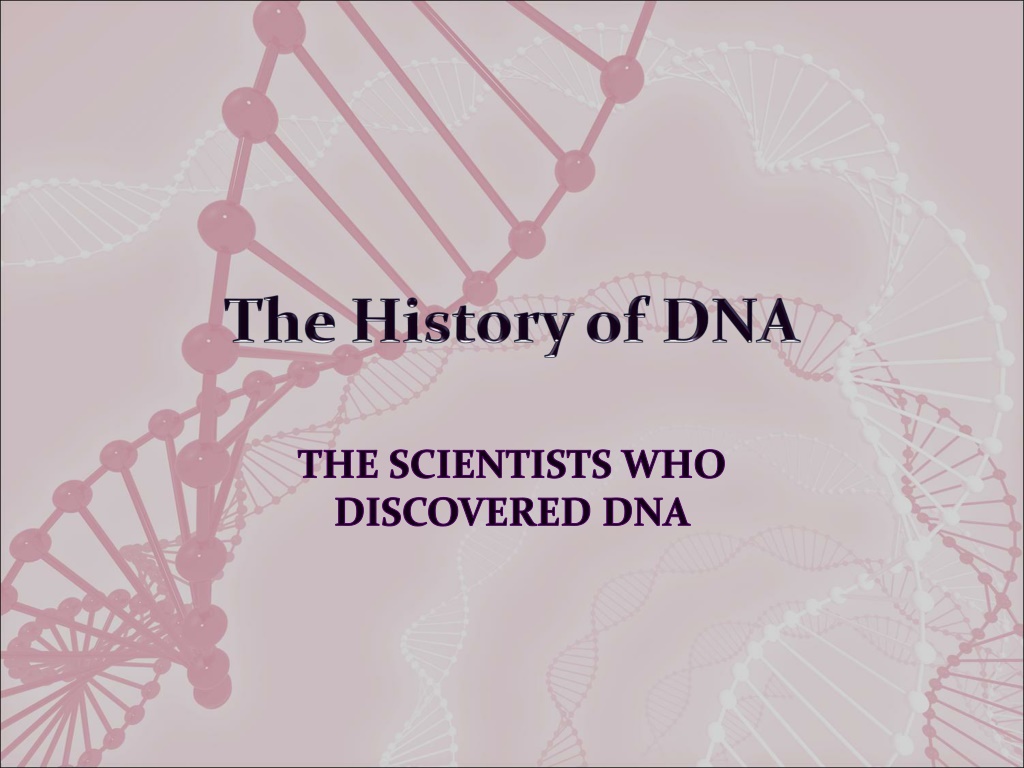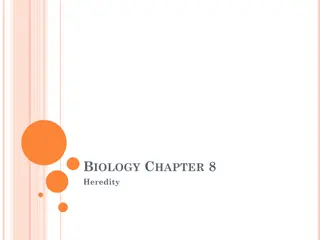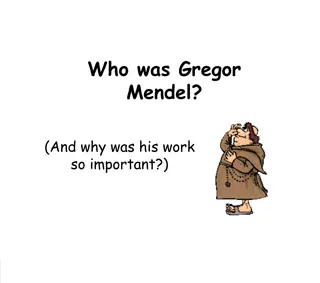The Pioneers of Genetics: Mendel and the Discovery of DNA
Explore the groundbreaking work of Gregor Mendel, known as the Father of Genetics, who studied pea plants to uncover the principles of inheritance. Follow the journey from Mendel's observations and results to the identification of DNA as the material responsible for passing on inherited information by scientists like Fredrick Griffith and Oswald Avery.
Download Presentation

Please find below an Image/Link to download the presentation.
The content on the website is provided AS IS for your information and personal use only. It may not be sold, licensed, or shared on other websites without obtaining consent from the author. Download presentation by click this link. If you encounter any issues during the download, it is possible that the publisher has removed the file from their server.
E N D
Presentation Transcript
THE SCIENTISTS WHO DISCOVERED DNA
Gregor Mendel Austrian monk Born in 1822 In monastery known for research and teaching After his death (1884) acknowledgment of his discoveries in 1900 Known as The Father of Genetics
Mendels Pea Plants First scientist to describe how traits are inherited Looked at pea plants for 8 years He studied 9 generations of plants
Mendels Observations He noticed that peas are easy to breed for pure traits and he called the pure strains purebreds. He developed pure strains of peas for seven different traits (i.e. tall or short, round or wrinkled, yellow or green, etc.) He crossed these pure strains to produce hybrids.
Mendels Results Mendel crossed purebred tall plants with purebred short plants and the first generation plants were all tall. When these tall offspring were crossed the result was a ratio of 3 tall to 1 short.
Dominant Trait Rule Strong Hereditary traits cover weak traits. Mendel called stronger traits DOMINANT Represented by CAPITAL LETTER (T) Mendel called weaker traits Recessive Represented by lower case letter (t)
File:Griffithm.jpg Fredrick Griffith Worked in the 1920 s Taxonomist a scientist who classifies and names organisms He specialized in pathogens (disease-causing organisms) Used mice and bacterium (Streptococcus pneumonia) to see if inherited material is passed though DNA or protein.
http://upload.wikimedia.org/wikipedia/commons/thumb/e/eb/Oswald_T._Avery_portrait_1937.jpg/150px-Oswald_T._Avery_portrait_1937.jpghttp://upload.wikimedia.org/wikipedia/commons/thumb/e/eb/Oswald_T._Avery_portrait_1937.jpg/150px-Oswald_T._Avery_portrait_1937.jpg Oswald Avery Continued Griffith s work Identified DNA as the material that passes on the inherited information. He used large amounts of bacteria and a process of heating and mixing the liquids to extract the nitrogen bases away from the protein Became world s first genetic engineer
Erwin Chargaff and his rule In 1950, biochemist Erwin Chargaff found that the arrangement of nitrogen bases in DNA varied widely, The amount of certain bases always occurred in a one-to-one ratio. Nitrogen bases always match up like this: Adenine Thymine and Cytosine -- Guanine
http://upload.wikimedia.org/wikipedia/en/thumb/9/97/Rosalind_Franklin.jpg/180px-Rosalind_Franklin.jpghttp://upload.wikimedia.org/wikipedia/en/thumb/9/97/Rosalind_Franklin.jpg/180px-Rosalind_Franklin.jpg Rosalind Franklin (1920-1953) Using X-ray techniques took pictures of DNA and discovered the double helix shape of DNA. Died of cancer due to unknown harmful affects of X-ray
James Watson and Francis Crick First scientists to create a model of DNA It is still the model used today Sides are made of sugar and phosphate molecules Rungs of the ladder are made of nitrogen bases Made of 5 elements: carbon, hydrogen, oxygen, nitrogen, and phosphorus
This powerpoint was kindly donated to www.worldofteaching.com http://www.worldofteaching.com Is home to well over a thousand powerpoints submitted by teachers. This a free site. Please visit and I hope it will help in your teaching























